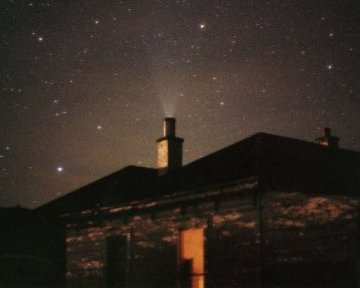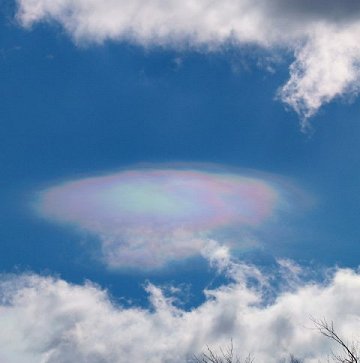 Cards, flowers, chocolate... what's missing? The heavens. Spaceweather PHONE for Valentine's Day.
Cards, flowers, chocolate... what's missing? The heavens. Spaceweather PHONE for Valentine's Day.
AURORA WATCH: A solar wind stream is expected to hit Earth on Feb. 14th, and the impact could cause a geomagnetic storm. Sky watchers from Scandinavia to Alaska should be alert for auroras on Valentine's Day.
COMET MCNAUGHT: People in cities of the Southern Hemisphere have been asking, what happened to Comet McNaught? Has it faded away? "No," says photographer Ian Cooper of Glen Oroua, New Zealand. "It's just stuck in my chimney."

Photo details: Nikon F, 50mm lens, f/2, 60 seconds, Fuji Xtra 800 film.
Actually, the comet has faded. Now about as bright as a 4th magnitude star, it is no longer visible from brightly-lit cites, but it can still be seen from rural areas and it remains an easy target for off-the-shelf digital cameras. Cooper captured the comet partially hidden behind his chimney with a 60-second exposure.
Comet McNaught Photo Gallery
[finder chart] [ephemeris] [comet camera]
'OIL SLICK' CLOUD: On Jan. 25th, cold air from Canada descended over Ohio, producing scattered snow showers and some very unusual clouds. "My wife thought this cloud looked like an alien spacecraft," says photographer Ed Kreminski, "but my kids thought it looked like a blimp on it's way to cover a sporting event."

Photo details: Olympus E-1, 50-200mm lens, ISO 100
A better analogy, says atmospheric optics expert Les Cowley, might be "an oily pool in the sky."
"The colors of oil films on puddles appear when light reflected from the top and bottom of the film merges together," he explains. "Light waves interfere, strengthening some colors and weakening others."
The same thing is happening in this iridescent cloud--except instead of oil, we have tiny water droplets. "The cloud is thin and it contains many droplets of about the same size. Light waves from different parts of individual water drops merge and interfere" creating the colors of an oil slick--without the greasy residue!

